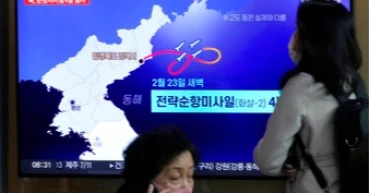long-range cruise missiles
North Korea says it test-fired long-range cruise missiles
North Korea said Friday it test-fired long-range cruise missiles in waters off its eastern coast a day earlier, adding to a provocative streak in weapons demonstrations as its rivals step up military training.
The U.S. and South Korean militaries didn’t immediately confirm the North Korean launches, which state media said were intended to verify the reliability of the missiles and the rapid-response capabilities of the unit that operates those weapons.
Read more: China calls for Russia-Ukraine cease-fire, peace talks
The launches would have taken place as the United States and South Korea held a simulated military exercise in Washington aimed at sharpening their response to North Korean nuclear threats.
Pyongyang’s official Korean Central News Agency said the exercise involved four missiles, which flew for nearly three hours after being launched from a northeastern coastal area, drawing oval and figure-eight patterns above the sea, and showed that they can hit targets 2,000 kilometers (1,240 miles) away.
North Korea first tested a long-range cruise missile system in September 2021 and has implied they are being developed to be armed with nuclear warheads.
It also test-fired an intercontinental ballistic missile Saturday and a pair of short-range missiles Monday to demonstrate a dual ability to conduct nuclear strikes on South Korea and the U.S. mainland.
Read more: Fears, questions about N. Korea's growing nuclear arsenal
North Korea said Monday’s short-range launches were a response to the United States flying B-1B bombers to the region for joint training with South Korean and Japanese warplanes on Sunday in a show of force following the North’s ICBM test.
Prior to the ICBM launch, North Korea vowed an “unprecedentedly” strong response over a series of military drills planned by Seoul and Washington. North Korea for decades has described the annual U.S.-South Korea drills as rehearsals for a potential invasion, although the allies say their exercises are defensive in nature.
Long-range cruise missiles are among a growing number of North Korean weapons and are designed to be maneuverable in flight to better evade missile defenses.
Since the collapse of nuclear negotiations with the United States in 2019, North Korea has been accelerating its development of short-range solid-fuel ballistic missiles targeting South Korea, including those that travel on low trajectories that theoretically make them harder to intercept.
Read more: N Korea calls UN chief's remarks on missile test 'unfair'
North Korea is also trying to develop solid-fuel ICBMs, which could be easier to move on vehicles and can be fired faster than the North’s existing liquid-fuel ICBMs, reducing opportunities for opponents to detect the launches and counter them.
The KCNA said Thursday’s tests were aimed at verifying the war readiness of its nuclear combat force, which is “bolstering up in every way its deadly nuclear counterattack capability against the hostile forces.”
North Korea is coming off a record year in weapons demonstrations with more than 70 ballistic missiles fired, including ICBMs with potential to reach the U.S. mainland. It also conducted what it described as simulated nuclear attacks against South Korean and U.S. targets in response to the allies’ joint military exercises.
Leader Kim Jong Un doubled down on his nuclear push entering 2023, calling for an “exponential increase” in nuclear warheads, mass production of battlefield tactical nuclear weapons targeting “enemy” South Korea and the development of more advanced ICBMs.
Read more: Russia, China show off ties amid maneuvering over Ukraine
The U.S. Department of Defense and South Korea’s Defense Ministry said the U.S. and South Korean militaries conducted a simulation at the Pentagon on Wednesday that was focused on the possibility of the North Korean use of nuclear weapons. The allies also discussed various adoptions to demonstrate their “strong response capabilities and resolve to response appropriately” to any North Korean nuclear use.
The Americans during the meeting highlighted the Biden administration’s 2022 Nuclear Posture Review, which states that any nuclear attack by North Korea against the United States or its allies and partners is “unacceptable and will result in the end of that regime,” the U.S. Department of Defense said. It was referring to a legislatively mandated document that spells out U.S. nuclear policy and strategy for the next five to 10 years.
Read more: North Korea confirms ICBM test, warns of more powerful steps
The U.S. and South Korean delegations also visited U.S. nuclear submarine training facilities at Naval Submarine Base Kings Bay in Georgia, where they were briefed on the mission of Ohio-class nuclear-powered ballistic missile submarines. U.S. officials at the base described such forces as key means of providing U.S. extended deterrence to allies, referring to a commitment to defend them with the full range of its military capabilities, including nuclear ones.
In face of the North’s growing threats, South Korea has been seeking stronger reassurances from the United States that it would swiftly and decisively use its nuclear capabilities to defend its ally from a North Korean nuclear attack.
“The United States will continue to work with (South Korea) to ensure an effective mix of capabilities, concepts, deployments, exercises, and tailored options to deter and, if necessary, respond to coercion and aggression by (North Korea),” the Department of Defense said in a statement.
The U.S. and South Korean militaries have another joint computer-simulated exercise and field training scheduled in March, which South Korean officials say would involve the allies’ biggest live-fire training in years.
2 years ago
North Korea says it tested new long-range cruise missiles
North Korea says it successfully test fired newly developed long-range cruise missiles over the weekend, its first known testing activity in months, underscoring how it continues to expand its military capabilities amid a stalemate in nuclear negotiations with the United States.
The Korean Central News Agency said Monday the cruise missiles, which had been under development for two years, demonstrated an ability to hit targets 1,500 kilometers (932 miles) away during flight tests on Saturday and Sunday.
The North hailed its new missiles as a “strategic weapon of great significance” that meets leader Kim Jong Un’s call to strengthen the country’s military might, implying that they were being developed with an intent to arm them with nuclear warheads.
Read:Leaders of North Korea, China vow to strengthen ties -
North Korean state media published photos of a projectile being fired from a launcher truck and an apparent missile with wings and tail fins traveling in the air.
South Korea’s Joint Chiefs of Staff said the military was analyzing the North Korean launches based on U.S. and South Korean intelligence. The U.S. Indo-Pacific Command said it was monitoring the situation with allies and that the North Korean activity reflects a continuing focus on “developing its military program and the threats that poses to its neighbors and the international community.”
Kim during a congress of the ruling Workers’ Party in January doubled down on his pledge to bolster his nuclear deterrent in the face of U.S. sanctions and pressure and issued a long wish list of new sophisticated assets, including longer-range intercontinental ballistic missiles, nuclear-powered submarines, spy satellites and tactical nuclear weapons. Kim also said then that his national defense scientists were developing “intermediate-range cruise missiles with the most powerful warheads in the world.”
North Korea’s weapons tests are meant to build a nuclear and missile program that can stand upto what it claims as U.S. and South Korean hostility, but they are also considered by outside analysts as ways to make its political demands clear to leaders in Washington and Seoul.
The North’s resumption of testing activity is likely an attempt at pressuring the Biden administration over the diplomatic freeze after Kim failed to leverage his arsenal for economic benefits during the the presidency of Donald Trump.
North Korea ended a yearlong pause in ballistic tests in March by firing two short-range ballistic missiles into the sea, continuing a tradition of testing new U.S. administrations with weapons demonstrations aimed at measuring Washington’s response and wresting concessions.
But there hadn’t been any known test launches for months after that as Kim focused national efforts on fending off the coronavirus and salvaging his economy.
KCNA said the missiles tested over the weekend traveled for 126 minutes “along an oval and pattern-8 flight orbits” above North Korean land and waters before hitting their targets.
“The test launches showed that the technical indices such as the thrust power of the newly developed turbine-blast engine, the missiles’ navigation control and the end guided hit accuracy by the combined guided mode met the requirements of designs. In all, the efficiency and practicality of the weapon system operation was confirmed to be excellent,” it said.
It appeared that Kim wasn’t in attendance to observe the tests. KCNA said Kim’s top military official, Pak Jong Chon, observed the test-firings and called for the country’s defense scientists to go “all out to increase” the North’s military capabilities.
Kim’s powerful sister last month hinted that North Korea was ready to resume weapons testing while issuing a statement berating the United States and South Korea for continuing their joint military exercises, which she said was the “most vivid expression of U.S. hostile policy.”
She then said the North would boost its pre-emptive strike capabilities while another senior official threatened unspecified countermeasures that would leave the allies facing a “security crisis.”
The allies say the drills are defensive in nature, but they have canceled or downsized them in recent years to create space for diplomacy or in response to COVID-19.
Talks between the United States and North Korea have stalled since the collapse of a summit between Trump and Kim in 2019, when the Americans rejected the North’s demand for major sanctions relief in exchange for a partial surrender of its nuclear capabilities. Kim’s government has so far rejected the Biden administration’s overtures for dialogue, demanding that Washington abandon its “hostile” policies first.
The latest tests came after Kim threw an unusual parade in capital Pyongyang last week that was a marked departure from past militaristic displays, showcasing anti-virus workers in hazmat suits and civil defense organizations involved in industrial work and rebuilding communities destroyed by floods instead of missiles and other provocative weaponry.
Experts said that the parade was focused on domestic unity as Kim now faces perhaps his toughest test with North Korea wrestling with U.S.-led economic sanctions over its nuclear weapons, pandemic border closures that are causing further strain to its broken economy, and food shortages worsened by floods in recent summers.
4 years ago



